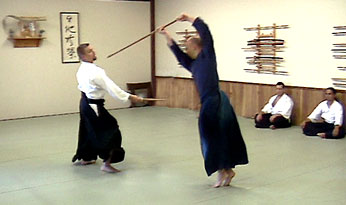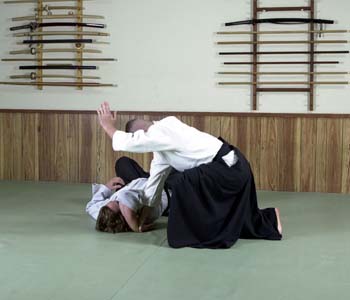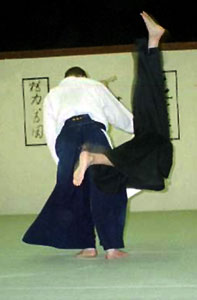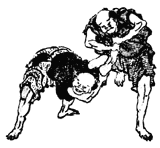

|
Some years ago I read something written by Trevor Leggett. Recently passed away, Leggett was the highest ranked non-Japanese by the Kodokan. He was a linguist, scholar, writer, and authority on Asian spirituality and budo. The piece I remember was about "Live Movement and Dead Movement." I've been thinking about this subject a lot lately and want to pass on some ideas in the Jiyushinkai Budo News. I think INTENT lies at the heart of the matter. We can learn principle, kata, techniques, etc. but unless we are also practicing the proper intent that these various things come from we miss the mark by a wide margin. Many people cannot feel the difference, but I think most of us SEE the difference. We may not know what the problem is - but we know something is lacking. |
|
|
 |
| Our kata movements may be "correct" in form, but the movement is often "dead" and useless for anything other than exercise. For example, making the honte dashi (natural pushing) movements properly in the Aiki Tandoku Undo (solitary aiki movements) exercise is not enough. We must have the strong intent to push/affect something with that movement. Imagine the target, make contact softly, and push through the target. The movement will then "come alive" and be useful. I can think of no appropriate use for "dead" movement in budo. Our kata must be alive! The katachi (spirit of the kata) must come from our intent and efficient, live movement actualizing our intent. |
 |
 |
Here we have the same technique done within the Koshi Waza no kata in different timing situations. As you can see, the photos are from different angles but look at the relaxed posture with strong intent in tori that produces dramatic and dynamic ukemi from the uke. Here tori's target is a point in space that he knows uke will reach at a precictable time, and then tori gets there with his hip entering that space just before uke settles there. This takes strong intent on: TARGET, DISTANCE, AND TIMING. |
|
|
Some people think the difference between live and dead movement is muscular force and speed added to the correct movement. That is not correct. If we keep these things in mind: Relaxed correct posture and movement; Target, Distance, and Timing...and then add the intent to cut or move through the target, we will develop "live" movement. We can see the difference in everything we do. Whether it is Shodo, Chado, Budo, or the way we do the dishes or sweep the floor, the difference between live and dead movement is obvious. There is lots more to this subject and next issue I'll write more about some practical things we can do in our everyday practice to help us develop LIVE movement. |
 |
|
|